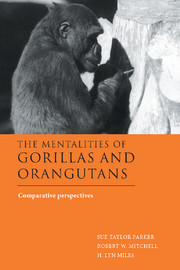Book contents
- Frontmatter
- Contents
- List of contributors
- Preface
- Acknowledgments
- I Comparative evolutionary and developmental perspectives on gorillas and orangutans
- II Cognition and tool use in gorillas and orangutans
- 4 Intelligent tool use in wild Sumatran orangutans
- 5 Orangutans' imitation of tool use: a cognitive interpretation
- 6 Object manipulation and skill organization in the complex food preparation of mountain gorillas
- 7 Development of sensorimotor intelligence in infant gorillas: the manipulation of objects in problem-solving and exploration
- 8 Tool use in captive gorillas
- 9 A survey of tool use in zoo gorillas
- III Communication in gorillas and orangutans
- IV Social cognition in gorillas and orangutans
- V Epilogue
- Index of authors
- Index of subjects
9 - A survey of tool use in zoo gorillas
Published online by Cambridge University Press: 20 October 2009
- Frontmatter
- Contents
- List of contributors
- Preface
- Acknowledgments
- I Comparative evolutionary and developmental perspectives on gorillas and orangutans
- II Cognition and tool use in gorillas and orangutans
- 4 Intelligent tool use in wild Sumatran orangutans
- 5 Orangutans' imitation of tool use: a cognitive interpretation
- 6 Object manipulation and skill organization in the complex food preparation of mountain gorillas
- 7 Development of sensorimotor intelligence in infant gorillas: the manipulation of objects in problem-solving and exploration
- 8 Tool use in captive gorillas
- 9 A survey of tool use in zoo gorillas
- III Communication in gorillas and orangutans
- IV Social cognition in gorillas and orangutans
- V Epilogue
- Index of authors
- Index of subjects
Summary
INTRODUCTION
Chimpanzees have long been famous for their tool use in the wild (Goodall, 1964), as well as in captivity (Köhler, 1927). Orangutans are now known to use tools in the wild (Van Schaik, Fox & Sitompul, 1996) as well as in captivity (Lethmate, 1982). Even bonobos, who are not known to use tools in the wild (Kano, 1986), are widely known for their tool use in captivity (Savage-Rumbaugh & Lewin, 1994). Of the great apes, only gorillas have been described as rarely using tools in captivity (McGrew, 1992), as well as never using tools in the wild (Schaller, 1963). In his review of tool use in great apes, McGrew (1992) cites only one report of tool use – use of a stick to rake in food – in captive gorillas. The idea that gorillas lack problem-solving capacities traces back to Yerkes' study of the gorilla Congo (Yerkes, 1927). Recently, this idea was reinforced by a study of the development of tool use in an infant gorilla (Natale, 1989)
On the other hand, at least two factors suggest that gorillas should be capable of tool use. First, gorillas display 5th- and 6th-stage sensorimotor cognitive abilities similar to those of other great apes (Chevalier-Skolnikoff, 1977; 1983), and tool use – at least, purposeful use of a variety of tools to solve problems – is an index of 5th-stage sensorimotor intelligence similar to that of 2–year-old human children (Piaget, 1952). Second, orangutans, gorillas, chimpanzees, bonobos, and humans are closely related sister species that share a common ancestor roughly dating back 14 to 18 million years ago (see Begun, this volume).
Information
- Type
- Chapter
- Information
- The Mentalities of Gorillas and OrangutansComparative Perspectives, pp. 188 - 194Publisher: Cambridge University PressPrint publication year: 1999
Accessibility standard: Unknown
Why this information is here
This section outlines the accessibility features of this content - including support for screen readers, full keyboard navigation and high-contrast display options. This may not be relevant for you.Accessibility Information
- 9
- Cited by
